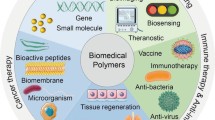Abstract
Biomaterial induced coagulation encompasses plasmatic and cellular processes. The functional loss of biomedical devices possibly resulting from these thrombotic reactions motivates the need for a better understanding of processes occurring at blood–biomaterial interfaces. Well defined model surfaces providing specific chemical–physical properties (self assembled monolayers (SAMs)) displaying hydrophobic or/and acidic terminal groups were used to uncover initial mechanisms of biomaterial induced coagulation. We investigated the influence of electrical charge and wettability on platelet- and contact activation, the two main actors of blood coagulation, which are often considered as separate mechanisms in biomaterials research. Our results show a dependence of contact activation on acidic surface groups and a correlation of platelet adhesion to surface hydrophobicity. Clot formation resulting from the interplay of blood platelets and contact activation was only found on surfaces combining both acidic and hydrophobic surface groups but not on monolayers displaying extreme hydrophobic/acidic properties.





Similar content being viewed by others
References
Krishnan A, Cha P, Liu YH, Allara D, Vogler EA. Interfacial energetics of blood plasma and serum adsorption to a hydrophobic self-assembled monolayer surface. Biomaterials. 2006;27:3187–94.
Blombäck B, Bark N. Fibrinopeptides and fibrin gel structure. Biophys Chem. 2004;112:147–51.
Zhuo R, Siedlecki CA, Vogler EA. Autoactivation of blood factor XII at hydrophilic and hydrophobic surfaces. Biomaterials. 2006;27:4325–32.
Rodrigues SN, Goncalves IC, Martins MC, Barbosa MA, Ratner BD. Fibrinogen adsorption, platelet adhesion and activation on mixed hydroxyl-/methyl-terminated self-assembled monolayers. Biomaterials. 2006;27:5357–67.
Martins CL, Ratner BD, Barbosa MA. Protein adsorption on mixtures of hydroxyl- and methylterminated alkanethiols self-assembled monolayers. J Biomed Mater Res. 2003;67A:158–71.
Benesch J, Svendheim S, Svensson SCT, Valiokas R, Liedberg B, Tengvall P. Protein adsorption to oligo (ethylene glycol) self-assembled monolayers: Experiments with fibrinogen, heparinized plasma, and serum. J Biomater Sci Polym Ed. 2001;12:581–97.
Lestelius M, Liedberg B, Tengvall P. In vitro plasma protein adsorption on w-functionalized alkanethiolate self-assembled monolayers. Langmuir. 1997;13:5900–8.
Faucheux N, Schweiss R, Lutzow K, Werner C, Groth T. Self-assembled monolayers with different terminating groups as model substrates for cell adhesion studies. Biomaterials. 2004;25:2721–30.
Barbosa JN, Barbosa MA, Águas AP. Inflammatory responses and cell adhesion to self-assembled monolayers of alkanethiolates on gold. Biomaterials. 2004;25:2557–63.
Sperling C, Schweiss RB, Streller U, Werner C. In vitro hemocompatibility of self-assembled monolayers displaying various functional groups. Biomaterials. 2005;26:6547–57.
Chuang W-H, Lin J-C. Surface characterization and platelet adhesion studies for the mixed self-assembled monolayers with amine and carboxylic acid terminated functionalities. J Biomed Mater Res A. 2007;82A:820–30.
Sperling C, Fischer M, Maitz FM, Werner C. Blood coagulation on biomaterial requires the combination of distinct activation processes. Biomaterials. 2009;30:4447–56.
Rodahl M, Hook F, Fredriksson C, Keller CA, Krozer A, Brzezinski P, et al. Simultaneous frequency and dissipation factor QCM measurements of biomolecular adsorption and cell adhesion. Faraday Discuss. 1997;107:229–46.
Grunkemeier JM, Tsai WB, Horbett TA. Hemocompatibility of treated polystyrene substrates: Contact activation, platelet adhesion, and procoagulant activity of adherent platelets. J Biomed Mater Res. 1998;41:657–70.
Racher A. LDH assay. In: Doyle A, Griffiths JB, editors. Cell and tissue culture: laboratory procedures in biotechnology. Chichester, New York, Weinheim: Wiley; 1998. p. 71–5.
Streller U, Sperling C, Hubner J, Hanke R, Werner C. Design and evaluation of novel blood incubation systems for in vitro hemocompatibility assessment of planar solid surfaces. J Biomed Mater Res. 2003;66B:379–90.
Sperling C, Maitz MF, Talkenberger S, Gouzy M-F, Groth T, Werner C. In vitro blood reactivity to hydroxylated and non-hydroxylated polymer surfaces. Biomaterials. 2007;28:3617–25.
Chen X, Wang J, Paszti Z, Wang F, Schrauben JN, Tarabara VV, et al. Ordered adsorption of coagulation factor XII on negatively charged polymer surfaces probed by sum frequency generation vibrational spectroscopy. Anal Bioanal Chem. 2007;388:65–72.
Evans-Nguyen KM, Schoenfisch MH. Fibrin proliferation at model surfaces: Influence of surface properties. Langmuir. 2005;21:1691–4.
Ostuni E, Chapman RG, Holmlin RE, Takayama S, Whitesides GM. A survey of structure–property relationships of surfaces that resist the adsorption of protein. Langmuir. 2001;17:5605–20.
Miyamoto M, Sasakawa S, Ozawa T, Kawaguchi H, Ohtsuka Y. Mechanisms of blood coagulation induced by latex particles and the roles of blood cells. Biomaterials. 1990;11:385–8.
Liebe S. Effect of ampholines on blood coagulation: 1. Activation of factor VIII (antihemophilic globulin A). Folia Haematol Int Mag Klin Morphol Blutforsch. 1975;102:454–61.
Sagnella S, Mai-Ngam K. Chitosan based surfactant polymers designed to improve blood compatibility on biomaterials. Colloids Surf B Biointerfaces. 2005;42:147–55.
Vroman L. The life of an artificial device in contact with blood. Bull N Y Acad Med. 1988;64:352–7.
Sanchez J, Lundquist PB, Elgue G, Larsson R, Olsson P. Measuring the degree of plasma contact activation induced by artificial materials. Thromb Res. 2002;105:407–12.
Kozin F, Cochrane CG. The contact activation system of plasma—biochemistry and pathophysiology. In: Gallin JI, Goldstein IM, Snyderman R, editors. Inflammation: basic principles and clinical correlates. 2nd ed. New York: Raven Press; 1992. p. 101–20.
Yarovaya GA, Blokhina TB, Neshkova EA. Contact system. New concepts on activation mechanisms and bioregulatory functions. Biochemistry. 2002;67:16–29.
Vogler EA, Graper JC, Harper GR, Sugg HW, Lander LM, Brittain WJ. Contact activation of the plasma coagulation cascade. I. Procoagulant surface chemistry and energy. J Biomed Mater Res. 1995;29:1005–16.
Schulman G, Hakim R, Arias R, Silverberg M, Kaplan AP, Arbeit L. Bradykinin generation by dialysis membranes: possible role in anaphylactic reaction. J Am Soc Nephrol. 1993;3:1563–9.
Gailani D, Renné T. Intrinsic pathway of coagulation and arterial thrombosis. Arterioscler Thromb Vasc Biol. 2007;27:2507–13.
Zarbock A, Polanowska-Grabowska RK, Ley K. Platelet-neutrophil-interactions: linking hemostasis and inflammation. Blood Rev. 2007;21:99–111.
Acknowledgements
We thank the Deutsche Forschungsgemeinschaft for funding (DFG SP 966/2-1) and acknowledge the technical support of Grit Eberth, who helped in SAM preparation and performance of hemocompatibility assays.
Author information
Authors and Affiliations
Corresponding author
Rights and permissions
About this article
Cite this article
Fischer, M., Sperling, C. & Werner, C. Synergistic effect of hydrophobic and anionic surface groups triggers blood coagulation in vitro. J Mater Sci: Mater Med 21, 931–937 (2010). https://doi.org/10.1007/s10856-009-3912-0
Received:
Accepted:
Published:
Issue Date:
DOI: https://doi.org/10.1007/s10856-009-3912-0




